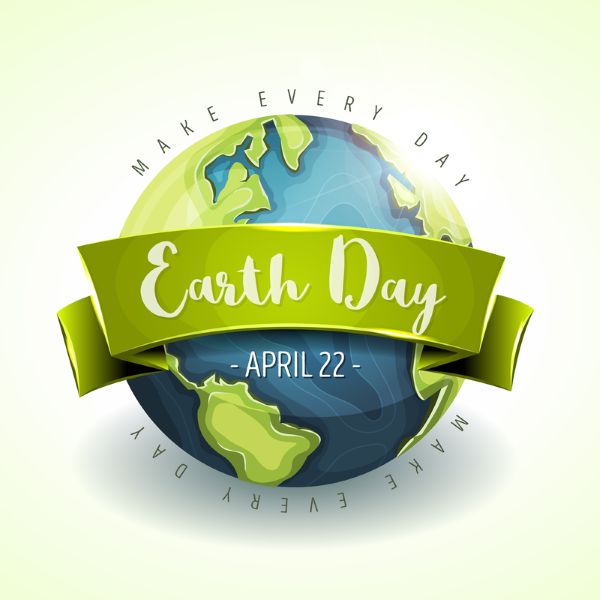I was 21 when the first Earth Day happened on April 22, 1970. I had broken both of my legs the year before and was on the way to full recovery. I had yet to meet my future wife. Having just achieved the age of majority, I tasted my first beer, a Heineken, and was embarking on a new academic path at the University of Toronto, having switched majors from physical geography and geology to medieval history. I don’t remember that first Earth Day. It was, however, a significant moment in time representing the first modern political action aimed at addressing the environment.
Atmospheric carbon dioxide (CO2) levels in 1970 were 325 parts per million (ppm), 75 points higher than at the start of the Industrial Revolution in the mid-19th century. Today, the CO2 measure is 427 ppm, 31% higher than on the first Earth Day. That doesn’t seem to be a number that is going in the right direction.
Earth Day inspired increasing awareness about environmental sustainability, particularly in Global North countries like the United States. Earth Day influenced U.S. legislation, including the passing of the Clean Air Act (1970), Clean Water Act (1972), and Endangered Species Act (1973), under the aegis of President Richard Nixon. America’s Environmental Protection Agency was launched in 1970.
Elsewhere, Earth Day inspired the beginning of non-profits focused on environmental justice. By 1990, Earth Day had mobilized more than 200 million people in 141 countries and established the growth of international environmental non-government organizations (NGOs) and grassroots groups.
The Natural Resources Defense Council (NRDC) and Sierra Club are among the American NGOs to establish themselves after that first Earth Day. Others include Earthjustice, a U.S. law group, and the Canadian Environmental Law Association (CELA) who began legal challenges to government inaction against polluters coincidentally with Earth Day.
Greenpeace, often controversial, was founded a year after the first Earth Day. Others inspired by Earth Day include the World Wildlife Fund (WWF), The Nature Conservancy (one of the oldest environmental groups, dating back to 1951), the Environmental Defense Fund (EDF), and the Earth Day Network (EDN).
Earth Day may have indirectly influenced the establishment of COP (Cooperation of the Parties), the United Nations conferences on the environment and climate change which was first held in 1995 and subsequently led to the Paris Climate Agreement of 2015 where 195 countries and the European Union nations collectively pledged to reduce atmospheric CO2 emissions.
So Earth Day is symbolically important even if it is increasingly ignored by the great majority. That’s why what is happening under the administration of Donald Trump is frightening in its potential consequences for our planet and humanity’s future.
Bill McKibben, one of the founders of 350.org, an environmental lobbyist group, noted in the organization’s April 17, 2025, newsletter, that Trump is targeting American environmental NGOs to strip them of their tax-exempt status. His political pressure on the Internal Revenue Service could lead to NGOs being audited. The NGOs are preparing a collective response on Earth Day by circulating a sign-on letter to organize and demonstrate against the administration.
Other actions by the Trump administration involve taking on state governments that are fining fossil fuel producers and utilities producing excess carbon emissions and pollution. Trump has ordered the federal Justice Department to take action against two states specifically, California and New York. The fossil fuel industry is ecstatic.
Then there is Trump’s initiative to revive and expand the coal industry, promoting what he calls “beautiful, clean coal.” He has ordered the EPA to roll back environmental regulations and the Interior Department to reopen federal lands to boost coal production. He has argued that coal-fired power plants could provide the energy needed for powering data centres dedicated to artificial intelligence. Meanwhile, burning coal produces more greenhouse gas emissions than any other fossil fuel. Mining coal and burning it contribute to soil and water pollution. Coal ash, a byproduct produced from burning it, is an environmental and health risk. The ash contains toxic levels of lead, mercury and arsenic, which get dumped into landfills or end up in rivers, lakes and groundwater. This is the “beautiful, clean coal industry” that Trump is excited to bring back.
Before this latest environmental insult by the current President, it should be noted that the decline in the burning of coal has been the single most significant contributor in lowering U.S. CO2 emissions to date. Now, the country is being directed by this “climate change is a hoax” President to reverse the little progress made in efforts to transition to a low-carbon future.
We ignore making every day Earth Day at our peril. If you are reading this posting, please share it with your friends and neighbours, and those who represent you in government. Earth Day needs a boost in these perilous times.









